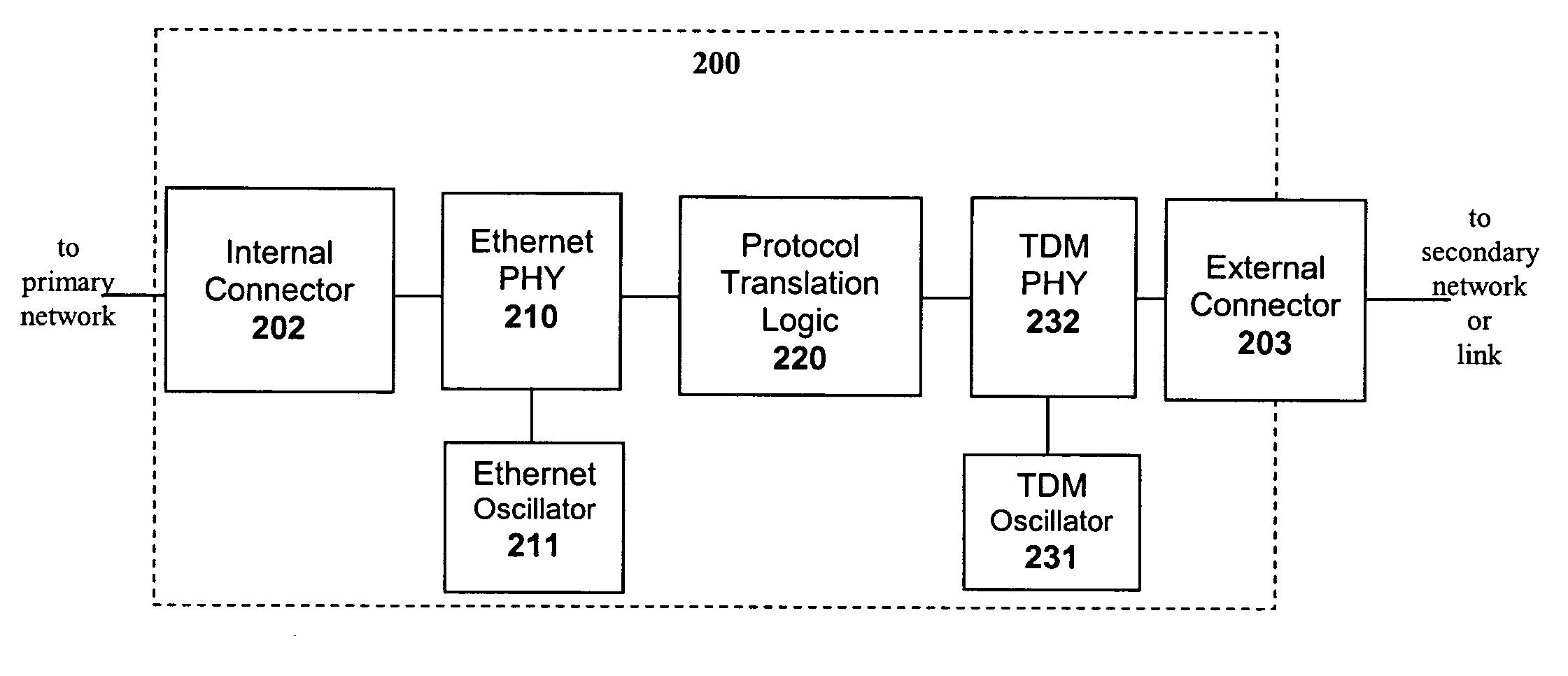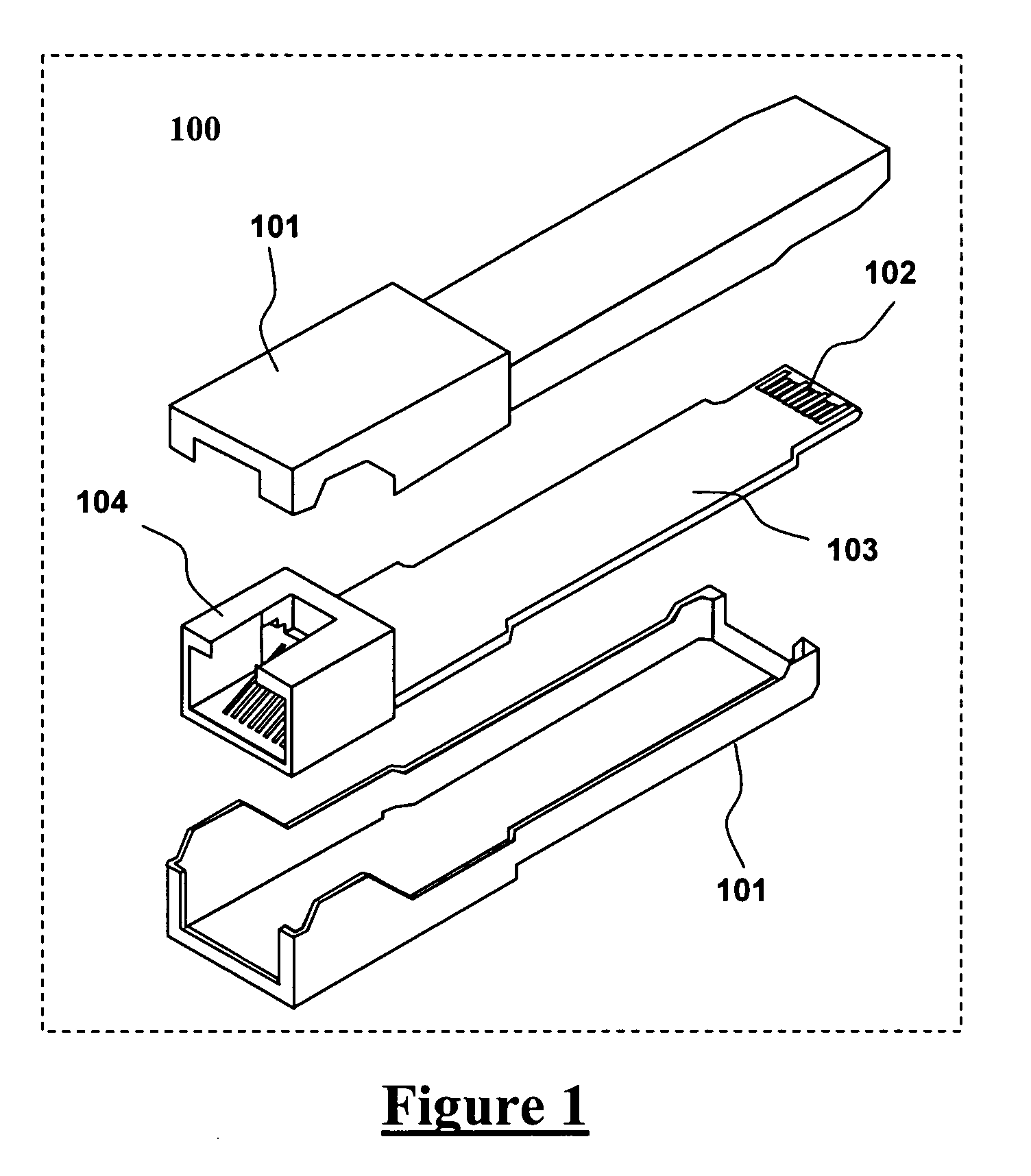Small form-factor device implementing protocol conversion
a technology of protocol conversion and small form factor, applied in the field of digital communication networks, can solve the problems of limiting the choice of transport means of users, limiting the physical extent of ethernet networks, and presenting barriers to communication between users
- Summary
- Abstract
- Description
- Claims
- Application Information
AI Technical Summary
Benefits of technology
Problems solved by technology
Method used
Image
Examples
first embodiment
[0051] In a first embodiment Ethernet frames are transported for long distances over a TDM link or network. A small form-factor transceiver module is connected to a suitable port of a standard Ethernet (such as 10 Mbit / s, 100 Mbit / s, or 1 Gbit / s Ethernet) switch connected to a first Ethernet network. Inside the small form-factor module the Ethernet frames are encoded using HDLC, Ethernet over LAPS, or GFP into a framed or unframed T1 or E1 bit-stream. This bit-stream is then encoded using an appropriate line code (e.g. AMI, B8ZS, HDB3) to produce a TDM physical layer signal that is applied to twisted-pair or coaxial cable via an appropriate connector on the exposed side of the small form-factor module. The twisted-pair or coaxial cable connected to the connector on the small form-factor module forms the secondary link. This cable may run for a long distance (e.g. 3000 feet for AMI) and may be extended further by employing repeaters or DSL modems. At its other end, the cable connects...
second embodiment
[0056] In a second embodiment T1 or E1 TDM traffic is transported across an Ethernet network, which may additionally have IP or MPLS higher layers. A first small form-factor transceiver module is plugged into a suitable port of a first Ethernet switch connected to a primary Ethernet network, and a second small form-factor transceiver module is plugged into a suitable port of a second Ethernet switch Ethernet switch connected to the same primary Ethernet network. The small form-factor modules are equipped with RJ or BNC connectors to which T1 or E1 TDM signals are applied. Accordingly, both small form-factor modules encapsulate TDM signals into Ethernet frames, e.g. according to ITU-T Recommendation Y.1413 for MPLS, or according to one of the IETF methods Structure Agnostic TDM over Packet (SAToP), TDM over IP (TDMoIP) or Circuit Emulation Service over Packet Switched Network (CESoPSN) for UDP / IP, or according to Metro Ethernet Forum (MEF) Implementation Agreement 8 for raw layer 2 E...
third embodiment
[0060] In a third embodiment ATM traffic is transported across an MPLS network. A first small form-factor transceiver module is plugged into a suitable port of a first MPLS Label Switched Router (LSR) connected to an MPLS network, and a second small form-factor transceiver module is plugged into a suitable port of a second LSR connected to the same MPLS network. Both small form-factor modules receive ATM traffic in any of the physical formats in which ATM may be delivered (including fiber-optic, copper, or ATM carried over TDM links). The ATM cells are extracted from whatever physical layer over which they are provided, and encapsulated according to either of ITU-T Recommendations Y.1411 or Y.1412 or similar ATM pseudowire specifications for tunneling across the MPLS network.
[0061]FIG. 4c depicts the use of a small form-factor module with protocol translation for the transport of ATM over an MPLS network (ATM pseudowire). A first small form-factor module 423 in a first MPLS Label Sw...
PUM
 Login to View More
Login to View More Abstract
Description
Claims
Application Information
 Login to View More
Login to View More - R&D
- Intellectual Property
- Life Sciences
- Materials
- Tech Scout
- Unparalleled Data Quality
- Higher Quality Content
- 60% Fewer Hallucinations
Browse by: Latest US Patents, China's latest patents, Technical Efficacy Thesaurus, Application Domain, Technology Topic, Popular Technical Reports.
© 2025 PatSnap. All rights reserved.Legal|Privacy policy|Modern Slavery Act Transparency Statement|Sitemap|About US| Contact US: help@patsnap.com



